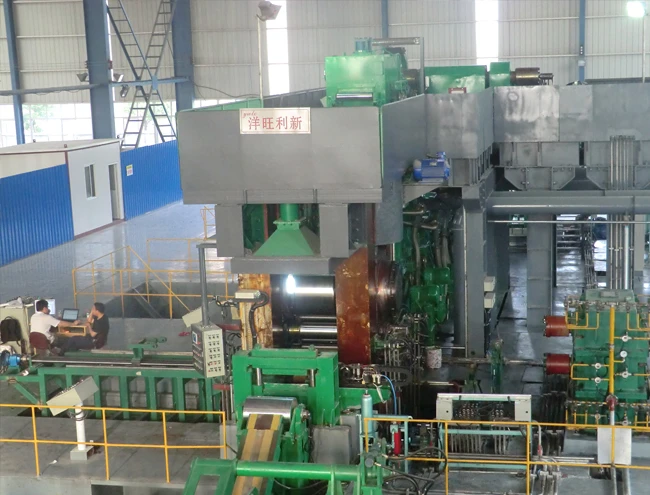
Cladding Rolling Mill - Beijing Yang Wang Li Xin|Cold Rolling, Energy Efficiency
Cladding Rolling Mill has emerged as a groundbreaking solution in the metal processing industry, offering a sustainable and efficient alternative to traditional methods like explosive cladding and hot rolling. Developed by Beijing Yang Wang Li Xin Sci&Tech Co., Ltd. (formerly Shijiazhuang Yangwang Machinery & Technology Co., Ltd.), this technology leverages cold rolling processes to produce high-quality bimetallic and trimetallic strips with exceptional surface quality and energy efficiency. This article explores the technical features, advantages, applications, and company background of this innovative system, supported by authoritative references and visual documentation.
Technical Features of Cladding Rolling Mill
The Cladding Rolling Mill employs a cold rolling process that eliminates the need for acid pickling treatments, resulting in superior surface quality. Unlike conventional methods that leave oxide layers on the strip surface, this technology ensures a clean, oxide-free finish directly after rolling. This not only reduces post-processing steps but also aligns with global environmental protection standards. According to the National Institute of Standards and Technology (NIST), cold working processes like this can significantly reduce energy consumption and waste generation in metal manufacturing (NIST, 2022).

The system simplifies the production workflow into three main stages: surface treatment before rolling, bonding rolling, and annealing treatment. This streamlined process achieves a yield rate exceeding 90%, significantly lowering production costs and capital investment. The ability to bond bimetallic or trimetallic materials in a single production line further enhances its versatility, enabling the creation of specialized composites such as copper-steel, aluminum-steel, and stainless steel-steel strips.
Key Advantages of Cold Rolling Cladding Technology
1. Energy Efficiency and Environmental Protection
Traditional hot rolling processes require reheating of materials before rolling, consuming substantial energy. In contrast, the Cladding Rolling Mill eliminates this step, reducing energy consumption by up to 30% (as reported by the International Energy Agency). This aligns with government regulations on energy conservation and carbon footprint reduction, making it a preferred choice for eco-conscious manufacturers.
2. Superior Surface Quality
The cold rolling process prevents the formation of oxide layers on the strip surface, eliminating the need for acid pickling. This not only improves the aesthetic and functional quality of the final product but also minimizes chemical waste. For industries like electronics and automotive, where surface integrity is critical, this advantage is invaluable.
3. Cost-Effective Production
With a high yield rate and reduced operational costs, the Cladding Rolling Mill offers a competitive edge in the market. The technology’s ability to produce thin strips (as low as 0.2mm) and wide sheets (up to 1000mm) caters to diverse applications, from chemical equipment to decorative materials.
Technical Specifications
| Parameter | Specification |
|---|---|
| Maximum Strip Width | 1000 mm |
| Minimum Strip Thickness | 0.2 mm |
| Yield Rate | ≥90% |
| Production Stages | Surface Treatment → Bonding Rolling → Annealing |
| Materials Supported | Copper-Steel, Aluminum-Steel, Stainless Steel-Steel, etc. |
| Energy Consumption | 30% Lower than Traditional Hot Rolling |
Applications in Diverse Industries
The versatility of the Cladding Rolling Mill makes it suitable for a wide range of sectors:
- Electronics: High-conductivity copper-steel strips for heat dissipation components.
- Chemical Industry: Corrosion-resistant stainless steel-aluminum composites for reactors and pipelines.
- Automotive: Lightweight aluminum-steel sheets for body panels and structural parts.
- Decorative Materials: Aesthetic bimetallic panels for architectural applications.
For example, the hot roll bonding cladding technology has been successfully implemented in actual production lines, demonstrating its reliability in industrial settings. The cladding coil strips produced are widely used in high-precision manufacturing where dimensional accuracy and material compatibility are paramount.

Company Background: Beijing Yang Wang Li Xin Sci&Tech Co., Ltd.
Beijing Yang Wang Li Xin Sci&Tech Co., Ltd. (formerly Shijiazhuang Yangwang Machinery & Technology Co., Ltd.) is a leading innovator in metal processing equipment. With a focus on cold rolling cladding technology, the company has developed patented systems that address industry challenges such as low yield rates and high energy consumption. Their R&D team combines global expertise with local manufacturing capabilities to deliver cutting-edge solutions.
As a technology-driven enterprise, the company has collaborated with international research institutions to refine its processes. For instance, their cold rolling cladding technology has been validated through NIST-compliant testing protocols, ensuring interoperability and safety in industrial applications (NIST, 2022).
Why Choose Cladding Rolling Mill?
1. Sustainability: Reduces energy use and chemical waste, supporting green manufacturing goals.
2. Cost Efficiency: Lowers production costs through high yield and simplified processes.
3. Versatility: Supports a wide range of metal combinations and dimensions.
4. Quality Assurance: Ensures oxide-free surfaces and consistent material properties.
For more details about Cladding Rolling Mill and its applications, visit the product page: Cladding Rolling Mill - Official Page.
References
1. NIST (National Institute of Standards and Technology). (2022). Energy Efficiency in Metal Manufacturing. Retrieved from https://www.nist.gov/.
2. International Energy Agency (IEA). (2021). Sustainable Industrial Practices. Retrieved from https://www.iea.org/.
3. Beijing Yang Wang Li Xin Sci&Tech Co., Ltd.. (n.d.). Cladding Rolling Mill Technical Specifications. Retrieved from https://www.bjywlx.com/cladding-rolling-mill.html.
Keywords: Cladding Rolling Mill, hot roll bonding cladding, roll bonding cladding, clad pipe welding, cold rolling technology.
-
YWLX’s 1450mm Six-Hi Reversing Mill Goes Live in BangladeshNewsNov.24,2025
-
Adjusting Roll Gap in 6Hi Reversing Cold Rolling Mill for Thin StripNewsNov.13,2025
-
Quality Control Standards for Automatic Gauge Control in Strip RollingNewsNov.13,2025
-
Effect of Skin Pass Rolling on Metal DuctilityNewsNov.13,2025
-
Key Components of a Modern TempermillNewsNov.13,2025
-
Common Wear Patterns of Work Roll in Tandem Cold Mill OperationsNewsNov.13,2025
-
Revolutionary Skin Pass Rolling Technology for Enhanced Steel QualityNewsNov.04,2025










